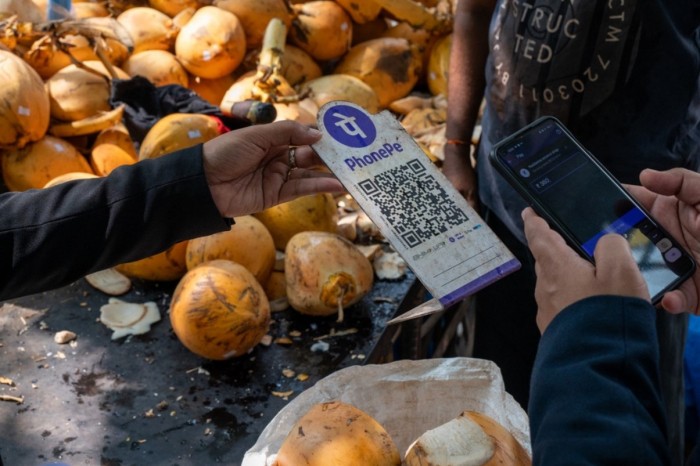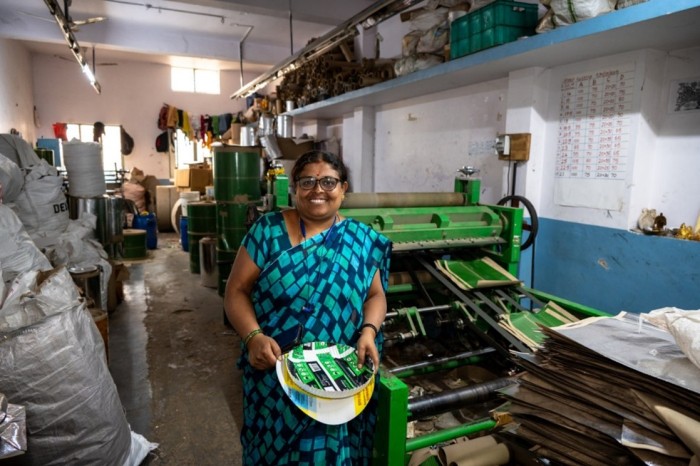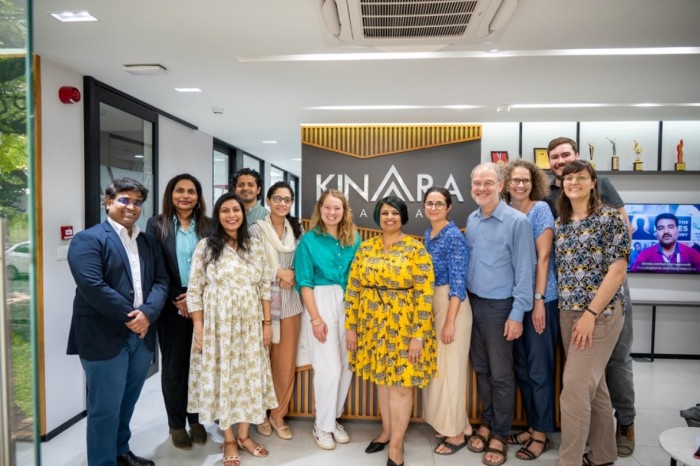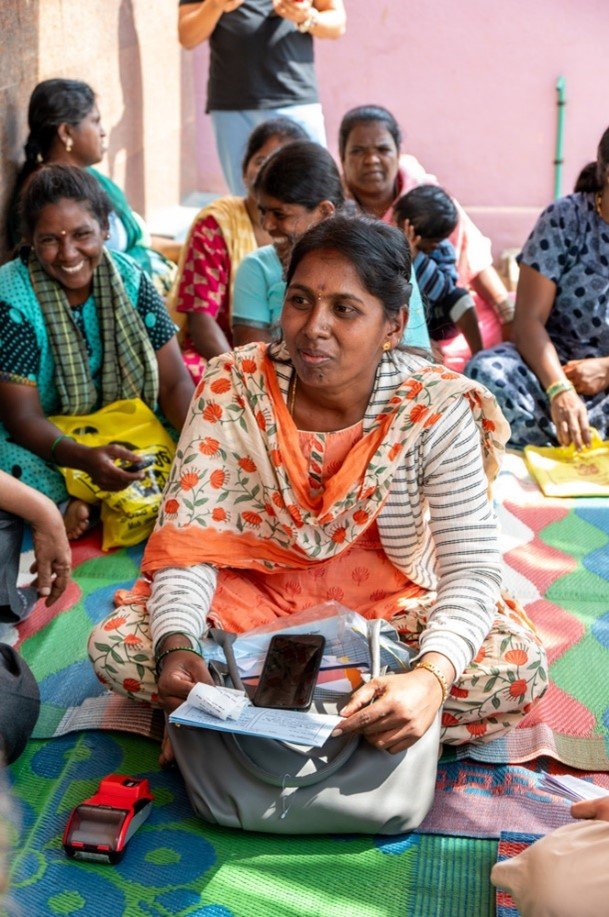Blog: The leapfrogging elephant : What India’s digital revolution means for Oikocredit and its partners
 January 24 | 2024
January 24 | 2024 India’s three-part strategy to grow financial and social inclusion enables microfinance institutions to serve clients quicker, with less risks. It’s digital transformation in action, says Ulrike Haug.
A digital revolution is underway in India and it’s changing the way Oikocredit and its partners serve low-income communities. The change was apparent to a group of 15 volunteers and staff from Oikocredit’s support associations during a one-week study tour in December 2023.
Study tours give participants a first-hand experience of how Oikocredit’s financing makes a difference in the lives of people with low incomes. When they return, attendees share their insights with other members of their support association and use their experience to promote the work of Oikocredit.
Ulrike Haug, responsible for global learning and advocacy at Oikocredit International, accompanied the group. In this blog she shares what she found most memorable: The speed and scope at which India is embracing a digital future.
Cash has lost its meaning
It is day two of our visit to Bengaluru (formerly Bangalore) and our support association colleagues have just finished an interview with Hardika Shah. She is the CEO and Founder of Oikocredit’s partner Kinara Capital, a financial institution that provides loans to small and medium enterprises.
Before we head off to visit several Kinara customers, we want to try the fresh coconuts sold from a small cart just outside the office. As we’ve learnt over the past few days, it’s no use trying to pay the vendor in cash. Most payments are now made digitally. A Kinara employee scans a QR code on his phone, enters the amount and confirms it with a click. An audio confirmation tells the vendor the transaction has been successful.

QR codes are omnipresent in India. Every street vendor, corner shop or small business has one. We also see a QR code in the office of our next interview partner, Kinara end-client Rukmini R. She runs a small enterprise producing paper plates which she sells to different distributors. They pay her digitally on the spot by scanning a QR code and the amount is instantly transferred to her bank account. Watch this video to learn more about Rukmini.
It feels like my previous visits to India, the last one only five years ago, were visits to another country. India’s economy has been called a ‘slow trundling elephant’, but this elephant certainly knows how to play leapfrog.
India’s digital revolution is not only changing the way people pay and bank, but also how they access or receive government services, as well as how they do business.
The transformation has a profound impact on Oikocredit’s partners. They’re able to serve their clients faster and with better insights that reduce their risks.
Mobile phones, digital IDs and bank accounts for almost everyone
The entire nation seems to have gone digital: 1.2 billion out of 1.4 billion inhabitants now have an affordable mobile phone with internet access at low rates. Though this does not necessarily mean that all phone owners benefit equally, (digital) literacy is still an issue. For example, a third of women who own a mobile phone are not able to read text messages.
Payments are largely made over mobile phones, using the Unified Payments Interface (UPI). Launched in 2016, this instant-payments interface enables transfers between bank accounts in real-time at no cost.
Ten years ago, almost half the population had no access to formal banking services, often because they could not afford the minimum deposit that was once required for opening a bank account. In 2014, India’s government launched the Jan Dhan bank account scheme which has since provided free, zero-balance bank accounts to more than half a billion people.
Having a bank account also allows people with low incomes to receive government subsidies in their account. Earlier, these payments were made in cash, and we are told some of the money often disappeared before reaching the beneficiary.
The third element of India’s digital revolution is Aadhaar, a unique identification system based on biometric data and photographs. Before its introduction in 2009, it is estimated that one in two Indians didn’t have a nationally accepted ID card. Since then, almost 1.4 billion Aadhaar identity cards have been distributed. The cards can also be linked to a smartphone, creating a digital identity. With an Aadhaar identity, opening a bank account or accessing digital services has become much easier and faster.
“The JAM trinity – Jan Dhan, Aadhaar, Mobile – has significantly accelerated the pace of digital financial inclusion in India,” says Anil Gupta from the consulting firm Microsave. In an introductory session at the start of the study tour, he explained to us the concept of the ‘India Stack’. It comprises several layers of digital infrastructure components. Different government agencies provide open-source application programming interfaces or APIs. These can be used to develop software solutions that can access IDs and other data. The objective: Fostering cashless, paperless and presence-less services to promote financial and social inclusion.

A game changer for financial inclusion and for our partners
Hardika Shah explains how the India Stack has changed the way Kinara Capital works: “Nowadays, the loan application process is fully digitalised and takes only 24 hours. Before India Stack, several people were involved in different manual steps and cross-checks. It took us 10 days to process a loan application.”
Potential clients now authorise Kinara to access their digital data which automates and speeds up the identity and credit bureau checks. With permissions to view tax filings, Kinara can better project a businesses’ income and understand its capacity for taking out loans.
“What we did not compromise on is the field visit,” says Hardika. “Our loan officers visit every potential customer to have an in-depth conversation and to verify data such as cash flow and to check their activity against our exclusion lists. Then we hit submit and the decision models run to calculate the risks. If these are acceptable, the loan decision is made and the proposal is sent to the client.”

MFI field officer: All it takes is a smartphone
The way that digital developments have changed the work of Oikocredit’s microfinance partners is also apparent the following day when we visit Initiatives for Development Foundation Financial Services (IDFFS). The microfinance institution offers loans and insurance products to women, mainly via groups. We meet one such group in the rural area of Tumkur, a few hours’ drive north of Bengaluru.
We learn from field officer Bhagyas how technology helps her manage relationships with her 430 customers, who are organised in groups in 10 different villages. She visits each group once a month to collect loan repayments. Through the company’s app, she can access each woman’s file and log the day’s repayments. The women then get a printed receipt.

The small printer also has a fingerprint scanner which is used when new clients are registered, making the identity check via the Aadhaar system fast and easy. It’s impressive to see how technology is used in onboarding clients, creating their digital file and managing repayments, all from the field officer’s smartphone.
As V.N. Salimath, Founder of IDFFS, explains, “The India Stack system helped a lot. Before, it took us 15-20 days for the checks and the application process, now it takes only six. The women get the money two days after the approval from our branch. I expect that in a few years, most of our clients will repay their loans digitally.”
India’s digital revolution: Who benefits?
During the week, we’ve learned how digital solutions enable our partners to provide better and faster services for their clients. According to the consultant Anil Gupta, the government also benefits, even though it has had to invest a lot in the initiatives and provide many digital services for free.
“By formalising the informal economy, government income from taxes will increase. In addition, the costs associated with a cash-based economy, such as printing rupee notes, will also decrease,” he says. As we have learned, paying out government benefits straight into bank accounts also reduces costs.
We understand that there are legal limits on the use of digital IDs and people have to consent for businesses to access their data. Nevertheless, in our group we wonder what risks might be associated with government agencies and companies collecting vast amounts of data.
We raise this question on the last day of the study tour when we once again meet colleagues who visited other partners in Pune and Hyderabad.
Mohua Mukherjee, Chairperson of Oikocredit’s Indian subsidiary Maanaveeya, provides some context: “If you ask people, they will likely tell you that they don’t mind data privacy issues. For them the benefits outweigh the risks by far.”
For my part, I’m curious to see how the digital landscape will develop and continue to transform India – and how other countries can learn from that. I hope to be able to visit this fascinating country again to see the changes to come.
Sources/Further reading:
- Conversations with Oikocredit staff and partners in India
- The India Stack: opening the digital marketplace to the masses (ft.com)
- Jan Dhan Yojana revolutionised financial inclusion in India: The Hindu
- Indien: Land im Aufbruch - brand eins online
- India is a ‘slow trundling elephant’ but a viable alternative to China: (cnbc.com)
- The India Stack is Revolutionizing Access to Finance - IMF F&D
Archive > 2024 > January
- January 30 | 2024 1/30/24, 10:16 AM - Oikocredit’s € 2.1 million loan to Sofipa to benefit women in rural Mexico
- January 24 | 2024 1/24/24, 1:14 PM - Blog: The leapfrogging elephant : What India’s digital revolution means for Oikocredit and its partners
- January 09 | 2024 1/9/24, 8:03 AM - US$ 5 million to improve livelihoods and food security in Kenya
- January 02 | 2024 1/2/24, 10:16 AM - How our cooperative navigated change in 2023 gives me confidence for 2024

